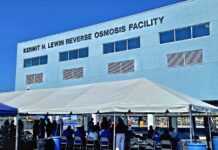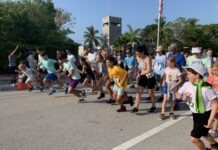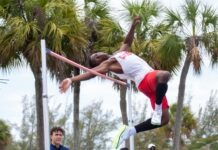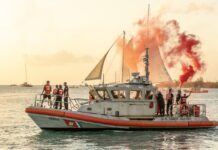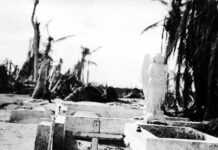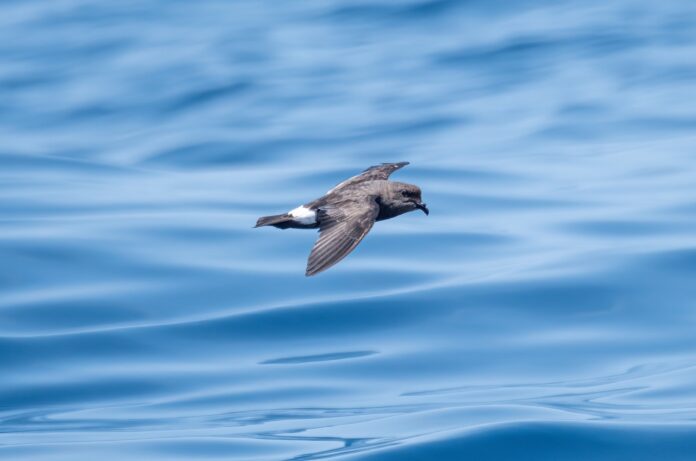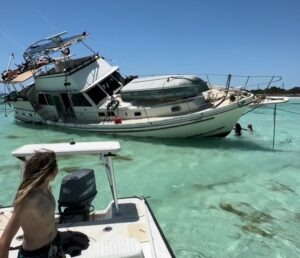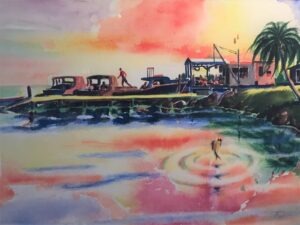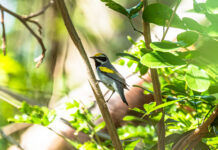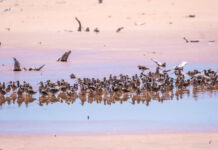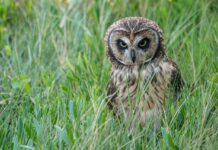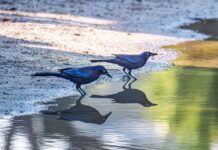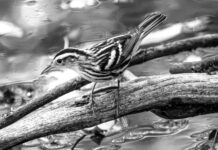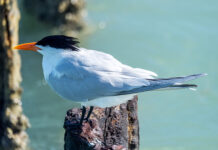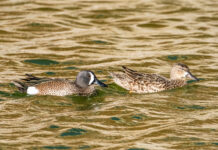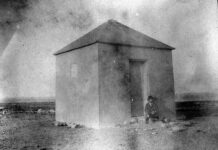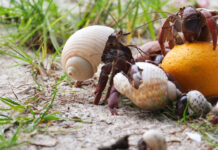We were 20 miles offshore, 70 miles from Havana, in about 900 feet of water, when Kevin Christman described the bird we were all watching as “cute.”
The bird was a storm-petrel, and it was flying around a chum slick dotted with popcorn and, I believe, Meow Mix, which is the kind of food that attracts a bird like a storm-petrel on the high seas. It was flying low over the slick in a pretty discursive manner, landing briefly on occasion, before taking off again and continuing its discursiveness.
It was a dark, round-bodied bird, with a white stripe across the base of its tail feathers. It looked a bit like an aquatic pigeon, if there was such a thing. It also had a somewhat bulbous forehead, making it looking reminiscent of a flying Beluga whale.
At first we thought it was a Wilson’s storm-petrel, because that’s the species you’re most likely to see in those waters. But Wilson’s storm-petrels have longish legs that extend out beyond their tail, and this bird did not. We ruled out Leach’s storm-petrel, as Leaches have a deep, v-shaped notch in their tail, and this bird did not. Which got us to band-rumped storm-petrel, which is kind of an appropriate name, with the bird having a band across its rump, though it is not the only storm-petrel with such a band.
Storm-petrels are thought to be some of the most common birds in the world, but people hardly ever see them. They are pelagic birds of the deepwater. They come to land only to breed. And when they do breed, they tend to do it in burrows on the cliff sides of out-of-the way islands. The closest places this bird could have been hatched were the Galapagos or the Azores.
Pelagic birding, which basically consists of driving around in a boat on the ocean, looking for birds, seems odd. It’s rather traditional in the birder world, but we weren’t a terribly experienced crew. Kevin had put the trip together. He’d done one other pelagic out of Homestead. Matt Jolley had done one off of Cape Cod. Steph and Kirby from up around Jupiter had never been on one before.
The captain of the Fishizzle, a 33-foot Mako with three very large Mercurys on the back, who was also named Kevin, was pretty game, though, steering the boat where we pointed, slowing down or stopping when we asked, and having some pretty good suggestions of where some birds might be.
I’ve done pelagic trips off of Islamorada, New Smyrna Beach, Cape Hatteras, NC, and Lima, Peru. I’ve also done about 30 runs out to the Dry Tortugas, almost always riding on deck, sometimes on the ferry, sometimes on overnight boats where we swung out into the deeper water to look for birds.
But, man, I never feel confident on a pelagic trip. For one, everything is in motion. And not only are the birds rarely at rest, they also tend to be pretty fast moving and distant. So you’re looking through binoculars, trying to pick up enough bits of visual information to coalesce into a clear perception of the needed field marks, while literally everything is in flux. And I tend to go years between pelagic trips, so I get rusty. A lot of times I find myself cramming with a field guide as the boat leaves the marina.
I’ve never in my life been seasick – knock wood – but staring for long periods of time through my 8×42 binoculars, or worse, through the long barrel of my 400mm camera lens, I sometimes get a notional inkling of what it might feel like.
As we pulled out of Key West Harbor that morning, there was a good sense of adventure. We were kind of making it up as we went along, as no one we knew had ever really done a pelagic off Key West. Who knew what we might find?
We went out through the main shipping channel, zigzagging between channel markers. Mostly we were seeing the white terns – least terns, sandwich terns, and a good number of roseate terns, which can be hard to see from land. We could see Sand Key in the distance to our right, and soon the water went from the familiar aqua of the nearshore to the rich sapphire blue of the deep water.
Soon, three backlit dark shapes flew past us. I went for my camera before I went for my binoculars, which was a rookie mistake, and I ended up getting neither a good look nor a good shot. Or any shot really. The results were the same for all of us. But logic-ing it out, the birds being terns but having no white on their bellies, we realized they were brown noddies.
Not too long afterward we came across a small flock of birds swooping and diving quickly into the water. There were more brown noddies. There were also other terns of similar size, but black and white, with that pied, tuxedoed vibe, making them sooty terns. Both breed at the Dry Tortugas, and I’ve seen thousands of each, but seeing them that far out at sea was a whole different experience.
In the next flock we found more sooties and noddies, but also Audubon’s shearwaters, which flew lower and had more rounded wings, and a tendency to bob on the surface of the water periodically. And then we began to see Cory’s shearwaters in the mix – brown, not black, and half again as big as the Audubon’s shearwaters.
After that we saw several flocks with pretty much the same makeup. I won’t say we became inured to the sooties, noddies and shearwaters, but as birders, you’re always craving something new. Which was when the band-rumped storm-petrel slid into view on the chum slick.
Kevin spent a lot of time wondering aloud if, being 20 miles offshore, it would be legitimate to add it to his Monroe County list. I’m actually terrible at, or at least terribly disinterested in, keeping lists, so I spent a few minutes wondering whether I’d seen a band-rump before, and came to the conclusion that I hadn’t. At least not that I could remember. So it was nice to pick up a lifer.
Also, I had to agree with Kevin that the bird was pretty cute. At least as far as pelagics go.


